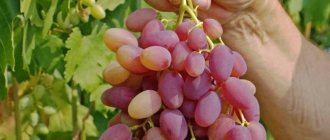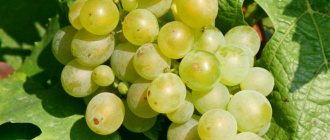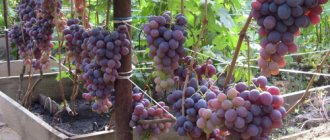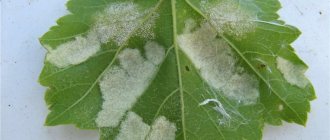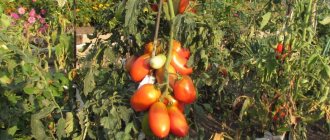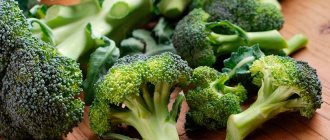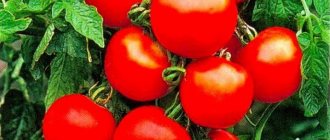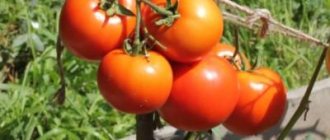The roots of the beautiful Lydia variety, which is loved by winegrowers in Moldova, Ukraine and southern Russia, go deep into history for its stable yield and beautiful appearance of the vines and ripe bunches, for the unique wonderful aroma of the berries. And the wine, jam, and juice from these grapes come out excellent. And Lydia appeared thanks to her ancestor’s resistance to diseases. But let’s not get ahead of ourselves, we’ll tell you everything in order.
- 2 What is good about Lydia
2.1 What do the numbers say about Lydia - table
- 3.1 Formation of the vine in the first years after planting - table
Advantages and disadvantages
Pros:
- The need for a minimum number of care activities.
- Absolute resistance to mildew and powdery mildew, as well as low temperatures.
- Excellent transportation, storage for several months.
- The presence of bisexual flowers on the bush.
- High sugar content.
Minuses:
- Vulnerability to phylloxera.
- Regular taste.
- The need for constant control over the number of shoots and stepchildren.
- Shedding of overripe berries from the stalk.
- Susceptibility to lime chlorosis due to a lack of iron in the soil.
Diseases and pests
The Lydia variety exhibits resistance to oidium and mildew. But special treatment is required to prevent other diseases.
Table: diseases affecting the variety
| Diseases | Symptoms | Treatment methods | Prevention |
| Anthracnose | Brown spots with a dark border form on the leaves. The affected tissue dies. | Treatment with fungicide Ridomil (25 g per 10 l of water), Thanos (3 packets per 10 l), Horus (3 g per 10 l). | Timely removal of plant residues. |
| Calcareous chlorosis |
|
| The correct choice of rootstock in accordance with the level of soil carbonate. |
| Gray rot | The bunches are covered with a gray coating. The berries rot, the inflorescences turn brown and dry out. | Use of soda solution (70 g per 10 liters of water). Diseased bunches and shoots need to be removed. | Ventilation of bushes. |
| Black spot |
| Spraying with Topaz (10 l ampoule), Horus, Thanos or Strobi (5 g per 10 l). | Prevention of mechanical damage to shoots. |
Photo gallery: typical ailments of Lydia
Anthracnose affects the leaves and shoots of grapes
Calcareous chlorosis causes leaves to fall off
Gray rot can deprive the entire crop
Black spotting weakens the development of the bush
Table: grape pests
| Pests | Signs | Ways to fight | Preventive measures |
| Spider mite |
|
| Removing weeds on which mites can develop. |
| leaf roller |
| Treatment of plants and soil in the spring with a solution of the insecticide DNOC. | Ensuring good lighting and ventilation of the bushes. |
| Phylloxera |
| Use of the drug Confidor (1 ml per half bucket of water). | Use fine-grained sand when planting, which is poured into a hole around the plant. |
Photo gallery: insects attacking crops
The leaf roller feeds on the juice of leaves and berries, depleting the crop
Spider mites weave webs around leaves and shoots, causing them to dry out
Phylloxera weakens the development of grapes
Origin
With the discovery of North America, not only tobacco and pineapple were brought to Europe, but also wild grape seedlings, which were extremely resistant to diseases and difficult climatic conditions. Along with him, oidium spores and phylloxera larvae came to the mainland, to which the “savage” developed a strong immunity. But the pampered European grape varieties immediately caught the “infection.” To save the culture, European winegrowers began to graft popular varieties onto the seasoned “foreigner”. This is how the “Lydia” grape appeared - the result of crossing the “American” “vitis labrusca” and the “European” “vitis vinifera”. The hybrid turned out to be fruitful and sweet, and they began to produce sweet dessert and semi-sweet wines from it. Parents of “Lydia” are “vitis labrusca” and “vitis vinifera”
Reference! In 1999, the production of wine from Lydia grapes was officially banned in the European Union and the United States. It contains a large amount of pectins, which, as a result of fermentation processes, are transformed into methanols. Their entry into the human body is fraught with serious problems with the liver, kidneys, brain, vision, and in high concentrations can even lead to death.
Lydia grapes: methods and methods of planting
There are winegrowers who practice a special method when planting Lydia grapes. To do this, a hole is dug in the fall. Drainage is laid at its bottom, which can be made from broken brick, gravel or expanded clay. Then the hole is filled with the excavated soil. Moreover, each layer of soil should be alternated with a layer of mineral fertilizers.
All layers are mixed very well with each other to form a homogeneous soil mass. By spring planting, the soil in the hole is very well infused. And planting materials can already be placed there in accordance with all the rules of agricultural technology.
Planting work is carried out in several main stages. Each step must be strictly followed. Because only in this case can you guarantee that the plant will take root well and grow. And then it will give a harvest, as it should be:
- It is best to prepare the trench for planting the planting material in advance. The less fertile the soil on the site, the deeper the hole should be dug for the seedling. If the bushes are poorly covered and shallowly planted, then when frost sets in, nothing will save them from freezing. Therefore, the hole should reach almost a meter in diameter. And up to half a meter deep;
- When preparing a trench, it is better to put the top layer of soil aside. Several layers are laid out in the trench. First, fertile soil. Then rotted compost. And then a layer of wood ash. The components should be mixed very thoroughly with each other. And you can add less fertile soil on top. The trench is spilled with water so that the soil settles;
- after 14-21 days, planting materials can be planted. To do this, it is enough to make several small holes in the trench for the bushes themselves;
- Before planting in open ground, the root system should be carefully inspected. And also straighten. Lydia grape seedlings are covered with earth. Moisturize generously with warm, settled water. It is best to mulch around the seedling.
Only one grape variety can be planted in one row. This is a very important rule. If the gardener plans to plant only the Lydia grape bush, then he should make not a trench, but a separate hole.
Main characteristics
“Lydia” is a technical variety from which wine and juice are produced. These grapes are used to make jam, jam, jelly, marmalade, confectionery and baked goods. “Lydia” can also be consumed fresh. Technical American varieties also include “Marquette”, “Alpha” and “Isabella”.
Ripening period
“Lydia” is a late-ripening variety. The entire growing season from the beginning of sap flow to the moment of harvesting takes 150-160 days, that is, you should prepare for harvesting the brushes somewhere in the middle - end of October. The ripening of berries does not occur simultaneously: those clusters that are located on the sunny side ripen first.
Bush
The bushes are considered medium in volume, but at the same time very thick, consisting of 80% fruit-bearing shoots. The most suitable form for them is a fan: the bush has one or more main branches growing from the ground, from which the vines are distributed in different directions along the trellis. Visually it is similar to a lady's fan.
The leaves of the variety are large, covered with fluff and cut into 3 or 5 lobes. The flowers are bisexual, which means self-pollination.
Bunches and berries
The clusters are small in size and weigh only 100 g. Their shape is cylindrical-conical, with several branches, which is why the entire structure of the cluster is loose and loose.
The berries also do not amaze the imagination with their size and weight: only 4 g in weight and 15 mm in diameter. Their round shape is pink-violet. The skin is dense, covered with a coating of wax and is easily separated from the pulp. The latter, in turn, is juicy, has a slimy consistency, and contains 3–4 seeds. The sugar content in the pulp is quite high - 18 - 20%, while acidity levels range from 5.5 to 9.3%.
Taste
“Lidiya” has an unusual taste: it clearly has berry and strawberry notes. The unsurpassed aroma of berries is also striking, very persistent and rich.
Productivity and ripening time
When planting a vineyard with self-rooted seedlings in the 2-3rd year after planting, the plant blooms and produces signal clusters; marketable fruiting begins in the 4th year, when one bush produces an average of 5-7 kg.
According to the results of experimental tests in the natural conditions of Tashkent (planting pattern 2.5 × 2.0 m with a fan formation), five-year-old plantings demonstrated a yield of 5-7 kg per bush or 8-14 t/ha (2000 bushes per 1 ha) .
When cultivating “Lydia” in Kakheti, a yield of 7-7.5 t/ha was recorded
Removable maturity occurs 140-160 days after bud break . The taste and aroma are revealed in the last ten days of September - mid-October. Full ripeness of berries in the regions of western Georgia is observed in the second half of October, but the harvest begins in mid-September.
The berries are weakly held on the stalks, but the tendency to massive shedding is observed mainly in strong gusty winds. If weather conditions are favorable, the clusters may hang until the first autumn frosts.
The slimy pulp, delicate in structure, is well protected from damage by a strong skin, which is not damaged during transportation. If harvested in a timely and competent manner, the fruits do not spoil and are stored in the refrigerator for more than 2 months. When hung, the clusters are preserved well even until February, but the taste of the berries gradually deteriorates, they wrinkle and fall off easily.
The opinion of an experienced Ukrainian gardener about the yield potential of “Lydia” can be found in the following video:
Features of cultivation
Proper care of grapes is the key to plant health and a high-quality and abundant harvest.
Landing
The versatility of the variety can also be seen in its propagation: planting can be done both in spring and autumn. Spring planting usually occurs in April or May. During the warm summer, the young plant takes root well, grows stronger and calmly prepares for wintering. True, additional efforts will be required in order to provide regular watering to the seedling, especially during drought.
Autumn planting is usually carried out in October: before the real harsh winter trials, the small plant still has time to take root and acclimatize. The risk arises when the thermometer begins to creep down: without additional, well-thought-out shelter, the seedling may die. The optimal soil temperature for planting grapes is from +10ºС, air temperature – from +15ºС.
Reference! “Lydia” is easily propagated in all possible ways: by sowing seeds, planting seedlings, using offsets and grafting cuttings. The most popular of them is rooting seedlings.
Place and soil
In order for “Lydia” to bear fruit successfully, several requirements must be met when planting:
- The location for the plot must be sunny and windless (preferably the southern part of the plot or vineyard).
- Soil fertility. The best option is chernozem or loam with an acidity pH of 6–7. It is important that the soil is loose and easily allows water and oxygen to pass through.
- Groundwater should not lie closer than 1.5 m from the surface.
- The optimal distance between future bushes should not be less than 1 m: “Lydia” is prone to thickening, which subsequently, if the established norm is not observed, will hinder the full development of the plant.
- The preparation of the planting pit should be done in advance so that the soil has time to settle a little. When planting in spring, the hole can be dug in the fall. Recommended depth – 90 cm.
- Filling the hole for the plant should be carried out strictly according to the algorithm: first drainage, then a mixture of organic matter, mineral fertilizers and fertile soil, on top - a layer of simple soil. It is important to ensure that the roots of the seedlings do not come into contact with fertilizers, otherwise they can be burned.
- After the young plant is buried to the middle, at least 10 liters of water should be poured under it, and after it is completely covered with soil - another 30 liters.
- A small peg is driven into the northern side of the young plant to support the new bush.
Important! “Lydia”, because of its large leaves and spreading vines, is often used for decorative purposes, decorating the walls of houses or gazebos, arches or fences with it. The main thing is that the decorative element of landscape design should be planted on the south side of the buildings.
Watering and fertilizing
The “Lydia” variety is relatively drought-resistant: the plant will safely survive a short absence of rain and high temperatures. But if the weather stays like this for a long time, then you should definitely water the bush systematically, otherwise the berries will be small and sour.
The recommended watering rate is 12 - 15 liters per bush. To make the circumference of the tree trunk circles easier, grooves are dug to a depth of 20 cm.
The variety is usually watered as planned:
- In the spring, immediately after pruning.
- After all the branches are tied to the trellis.
- When the shoots grow to 25 cm in length.
- Before and after flowering.
- During ripening.
- After the harvest.
To retain moisture in the roots, it is advisable to mulch the soil around the plant trunk using peat, humus, sawdust, and grass. Such raw materials will not only become an obstacle to the evaporation of moisture, but will also serve as a good fertilizer.
For abundant fruiting, Lydia grapes need fertilizing. Experienced winegrowers recommend applying fertilizers every season according to the following scheme:
- In March and 2 weeks before flowering: per bucket of water: 10 g of ammonium nitrate, 20 g of double superphosphate, 5 g of potassium salt.
- Before ripening: 20 g of double superphosphate, 5 g of potassium salt per bucket of water.
- After harvest: 15 g of potassium chloride per 1 m2.
Trimming
Professional winegrowers recommend pruning “Lydia” vines to 6–8 buds. It is also necessary to remove unnecessary stepsons and shorten shoots in the second half of June.
The bush should be formed from the second year of life of the grapes, making 3 prunings per season:
- Spring pruning involves removing dried and damaged branches. It is performed even before the start of sap flow, at an air temperature of +5ºС.
- In summer, bushes are thinned to ensure ventilation.
- In the fall (October - November) the most important pruning is performed: in the first year - by 2 - 4 eyes, in the second - by 6 - 8, and in the third - by 15. The recommended load of an adult bush is 35 - 50 eyes.
Diseases and pests
The “Lydia” variety is resistant to oidium and mildew, but the gardener often faces the problem of chlorosis, anthracnose and gray rot on the plant. Grapes are also susceptible to attacks from phylloxera, which strikingly distinguishes them from their “progenitor,” as well as spider mites and leaf rollers.
To protect the variety from infection, it is necessary to carry out timely preventive irrigation of the bushes with fungicides and insecticides, and also to ensure that debris of dry grass and fallen leaves do not accumulate under the plant. After harvesting, the soil under the bush needs to be dug up, and one should not forget about timely application of fertilizers.
Lydia berries attract birds and wasps. They also need to be fought, otherwise the winegrower may lose a significant share of the harvest or harvest fairly spoiled fruits. You can protect the bunches with special mesh caps or fence the entire grape planting with stretched nets. Optical, ultrasonic or simply sound repellers will help in the fight against birds, which can be purchased in specialized stores or built independently (a hanging bell, foil strips). Placed sweet baits and traps will help against wasps, and chemical treatment as a last resort.
Wintering
“Lydia” is able to safely survive a temperature drop to -26ºС. If such a temperature jump is single, then in warm winter conditions the plant does not need shelter. However, in regions with a temperate climate, the insulation of grape bushes should not be neglected.
The covering process is simple: in November, the branches are removed from the trellises, laid on the ground, tied, after which they are sprinkled with a 10-15 cm layer of earth. A kind of protection can be strengthened with boards supporting the sides of the structure.
Storage
Ripe clusters of Lydia grapes should not hang on the bushes for a long time: overripe berries will begin to fall off. Timely harvested crops are stored in boxes up to 15 kg with ventilation holes.
Recommended storage conditions are 0 -3ºС and 90 - 95% humidity. The variety will last for about 3 months in such conditions without problems, but in the refrigerator (+8ºС) – about 2 months.
The thick skin of the berries is the key to successful transportation of the bunches, so grapes can be transported over long distances without fear.
Important! The variety is considered high-yielding. On one shoot of “lydia” 2–5 clusters ripen, which makes it possible to harvest up to 30 kg of fruit from a bush, and up to 130 centners from a hectare.
Regions
The variety feels great in the southern regions of the Russian Federation and countries: Moldova, Ukraine. It has successfully acclimatized in regions with temperate climates and in the northern regions.
The only condition is that the plant must be insulated for the winter.
Description of the plant and specifics of cultivation
The vine is distinguished by its great growth vigor and well-ripening shoots. The perennial parts of the bush are covered with reddish, coarse-fibrous bark. The leaves are simple, large, round, mostly three-lobed or almost entire, smooth, dark green above, greenish-white below, with dense pubescence. The lateral notches are barely outlined or deep, obtuse, wide, with a rounded bottom. The petiole recess is open, vaulted, with a sharp bottom. The teeth at the ends of the blades are straight, triangular, with sharp tips. Along the edge - small or alternating with large ones. The petiole is equal in length to the midrib or shorter than it.
The flowers are greenish, small (3-5 mm in diameter), bisexual. For "Lydia" there is no need to select additional pollinators. According to reviews from gardeners, severe shedding of flowers and “peas” are not observed in the variety.
Bushes are vigorous, with well-ripening shoots
Fruitful shoots range from 65 to 85%, on average the load on each is 1.5 bunches (maximum 2.4). The plants develop well fruitful shoots from old wood and replacement buds even in cases of freezing or damping off of the central buds, which contributes to stable yields. The most developed shoots are left for fruiting. It is considered advisable to trim short - by 2-4 buds, or medium - by 6-8.
The yield of the variety directly depends on the soil and climatic conditions of growing the vine and the methods of forming the bushes. The most effective are: single- and double-sided, with one and two fruit links, without a standard and standard ones. An example is the so-called “Georgian” formation - one- or two-shouldered Guyot.
Four-year-old bushes formed according to the Guyot double-arm system (before pruning)
For “Lydia” it is recommended to leave approximately 25-30 healthy eyes per bush when cultivating according to the double-arm cordon type, which includes: planting according to a 2x1.5 m pattern, growing two mature strong shoots; creating a twisted trunk from them to the first tier of trellis wire at a height of 0.5-1 m; the formation of two horizontal shoulders of a cordon with fruit links, tying green growth to the wire of the second or third tier of the trellis, followed by free hanging.
Comparison with analogues
From America in 1948, the technical variety of black grapes “alpha” was also brought to the territory of the USSR.
Photo of “alpha”
Just like “Lydia,” “American” ripens only for 150 days, has a bisexual flower, is used in landscaping walls and balconies, has a slimy pulp and a cylindrical-conical shape of the brush.
In favor of “Lydia” is the fact that “alpha” is not resistant to mildew, chlorosis and oidium. But this variety is ahead of “Lydia” in terms of frost resistance: it can easily survive frosts of -35ºС. And the yield of “alpha” is higher – up to 150 centners per hectare.
The versatile pink grape variety “Korolek” is also used for wine production. Its advantage is evidenced by its early ripening period, large clusters (up to 1 kg) and berries (up to 12 g), interesting taste with nutmeg notes, and invulnerability to wasps.
It is related to “Lydia” in terms of sugar content (19 – 21%) and frost resistance (up to -26ºС). But the “kinglet” is not in favor of problematic compatibility with rootstocks, the presence of only female flowers on the bushes and vulnerability to a significant list of diseases and pests.
What's so good about Lydia
Lydia's bush growth is above average. In the southern regions, where it overwinters without shelter, the vine can be used for vertical gardening. The shoots of this grape ripen well. During the growing season, Lydia's bushes become very thick, so they definitely need to be chased and pinched. This variety begins to bear fruit at the age of three years .
In the southern regions, where Lydia winters without shelter, it can be used for landscaping the walls of houses, gazebos, and arches
Lydia is a medium-ripening variety . The grape bunches are of medium size, loose, branched, and shaped like a cone or cylinder. The berries are round, when ripe their color is dark red, sweet and juicy. The tough skin is covered with a lilac waxy coating, and the slimy pulp has an aroma reminiscent of strawberries. When the berries ripen, they are weaker on the stalks, so timely harvesting will help preserve the harvest. This is especially important in areas with strong winds.
Lydia's resistance to low temperatures is much better than that of European varieties. It is so resistant to powdery mildew and mildew that it does not need to be treated with drugs against fungal diseases, but it must be sprayed against phylloxera . Lydia copes better with high soil moisture or salinity than other varieties.
Lydia is a grape with a medium ripening period, productive, with good quality berries and frost-resistant
What do the numbers say about Lydia - table
| Ripening period from the beginning of the growing season | 150–160 days |
| Sum of active temperatures from the beginning of the growing season to technological maturity | 3090 ºС |
| Average bunch weight of the Druzhba variety | 100–110 g, large ones – 200–300 g |
| Average berry size | Ø15 mm |
| Average berry weight | 3–4 grams |
| Calorie content of 100 g of berries | 70–75 kcal. |
| Sugar content | 180–190 g/dm3 |
| Amount of acid in 1 liter of juice | 5.5–9.3 grams |
| Productivity per hectare | up to 10–12 tons |
| Frost resistance | up to -26 ºС |
Benefits and harms
Reference! 100 g of Lydia grapes contain 75 kcal and a huge amount of useful microelements.
This variety is recommended for regular consumption by those who want to cleanse the body of waste and toxins, who have been seriously ill or who are engaged in heavy physical labor.
Patients with diabetes mellitus and stomach ulcers should exclude “Lidiya” from the diet.
Preparing the vine for wintering
Lydia grapes belong to frost-resistant varieties. However, additional shelter will not be superfluous, especially in regions where winters are very harsh. A newly planted vine definitely needs shelter. It is recommended to take time for covering work in November: the Lydia vine is carefully removed from the trellis, tied and sprinkled with a layer of earth. In this way, a bed of 10-15 cm is formed.
Photo
Below, check out the photos and reviews about the “Lidiya” grape variety.
History of selection
Several centuries ago, the wild grape variety Vitis labrusca was brought to the European continent from America. The main positive quality of this grape was its high resistance to most diseases characteristic of this berry crop, including fungal diseases.
Breeders paid attention to this feature of the introduced vineyard and began to graft cultivated varieties of this plant onto the underground stems of Vitis labrusca. As a result, new varieties of grapes appeared that were highly resistant to powdery mildew, phylloxera and many other fungal diseases.
Photo of Lydia grapes
This is how the Lydia grape variety was developed, which is distinguished by good yield and high sugar content in ripe grape clusters. Therefore, for decades it was grown by winegrowers in the southern Russian regions, the Caucasus, the Lower Volga and many other areas for the further production of semi-sweet or table wine. But the bunches of these grapes can also be used for food.
In recent years, they began to grow less Lydia grapes, as many new varieties with improved performance have appeared, but there are summer residents who respect traditions and value time-tested quality.
Reviews
Ripens in Kharkov conditions - mid or late September. A very unpretentious variety and has never been processed with anything. And the wine made from it is not bad. Mikhail Leonidovich, Kharkov
Unpretentious in care - quite a worthy variety “for lazy people.” Oleg Davidovich, Krasnodar
There were 3 attempts to make wine, but it turned out a bit cloudy. Viktor Sergeevich, Kiev region, Boryspil
My Lydia grows on its own without winter shelter or care, on a neighbor’s plum tree. Vladimir, Saratov
We make wine from it all the time. The wine has the purest and most beautiful aroma of strawberries. Ivan, Samara
Harvest
Ripe clusters can be collected 145-156 days after the first ovaries; most often, harvesting time occurs at the end of August or September. In a good year, one bush produces at least 30-35 kg of fruit. A special feature of the Lydia variety is that ripe berries easily fall off, so the clusters are collected in dry, windless weather.
When cutting bunches of the Lydia variety, they are immediately inspected - damaged berries are laid aside separately. Boxes with holes are suitable as containers for ventilation of the crop. Do not collect more than 13 kg in one box, as the grapes may become wrinkled.
Advice! To preserve the harvest, it is advisable to allocate a room where the air temperature is maintained within 0-3˚ C and constant humidity - 90-94%.
A special advantage of Lydia grapes is that they can be enjoyed both fresh and canned (compotes, jams).
Landing
Lydia seedlings can be planted both in spring, in April or May, and in autumn, in October. The main thing is that the soil temperature is not lower than + 10°C, and the air temperature is not lower than + 15°C. This variety takes root well when planted by cuttings. They are cut from shoots in the fall, about 45 cm long, the stepsons, leaves, tendrils are removed, and three to four eyes are left on each. Then:
- keep for a day in water with a temperature of + 23°C;
- sprayed with a solution of potassium permanganate;
- slightly dry;
- wrapped in plastic film;
- sent for storage in a cellar or refrigerator;
- in March they are taken out and placed in water at room temperature for 48 hours;
- make cuts three mm from the lower eye and two cm from the upper one, this is necessary for better germination;
- the top is dipped in paraffin;
- At the bottom of the cutting, small cuts are made along the bark - roots will grow from them.
Planting is done as follows:
- Dig holes 0.8-0.9 m wide and deep.
- Lay drainage made of expanded clay, pebbles, crushed stone, gravel or broken bricks at the bottom. Some winegrowers use branches for this purpose.
- Then a soil mixture with fertilizers is prepared. To one part of the turf soil add one part of river sand, one part of humus, 50 g of nitroammophosphate, the same amount of superphosphate and 20 g of ammonium nitrate. Mix everything well.
- The prepared nutrient mixture is placed on the drainage.
- And then the earth removed when digging the hole.
- Watered.
- Let the pit settle.
- The soil in the hole is loosened and a mound is formed.
- The seedling is placed on a mound at a slight slope; the root collar should rise above the soil surface.
- Sprinkle with earth, trample and water.
- Mulch with mowed grass, humus, straw or sawdust.
The pits are prepared in advance, at least one or two weeks in advance; ideally, for spring planting, prepare the soil for grapes in the fall.
Wine with a characteristic strawberry flavor is made from Lydia grapes
When choosing a place for a vineyard, you need to take into account that Lydia prefers chernozems or light sandy loam soils with an acidity in the range of 6-7 pH. In this case, groundwater should lie no closer than 1.5-2 m from the surface. There should be plenty of sunlight and no drafts.
Features of care throughout the year
Grapes also need care throughout the year. And if everything is clear with autumn pruning, then in the summer you need to rid the plant of weeds, loosen the soil around the bush, and protect it from pests. Treatment for parasites and diseases is carried out 2-3 times a year. For this, any insecticides or herbicides that are sold in country stores or garden centers are used. Process according to instructions.
In the fall, after the leaves have fallen on the bush, you can cover the plant and mulch it with peat or coniferous mass. This way the soil will be protected from frost. Grape bushes are wrapped in agrofibre, sometimes additionally covered with a protective film.
How to make juice at home?
The excellent taste of this variety contributes to the production of aromatic juice. At the same time, making juice from Lydia grapes at home is simple:
- The berries must be washed well and cleared of branches.
- Squeeze out the juice, while periodically cleaning the juicer from the pulp.
- Strain the resulting mixture through a sieve.
- If the juice is concentrated, then it is diluted with water.
- Boil the juice for 10 minutes.
- Pour it into sterilized jars and seal immediately.
For storage, you need to use sterilized containers, otherwise the juice may ferment.
Benefits of use
All fruits have beneficial properties. Lydia grapes were no exception. Whether its use will be beneficial or harmful depends largely on the consumer’s sense of proportion. At the same time, grapes have the following beneficial properties:
- has a large amount of vitamins A, B6 and C and minerals - potassium, iron, calcium and phosphorus;
- is an antioxidant, that is, it slows down the aging process;
- has a beneficial effect on the heart, preventing the formation of blood clots;
- relieves nervous tension.
Tips and tricks from experienced gardeners
The most important thing when growing Lydia grapes is to quickly respond to diseases and ripening. Then you can reap a bountiful harvest from each plant.
Lydia grapes will not require much maintenance, but will delight the owner with delicious berries.
“In Abkhazia they grow such grapes, but they have a different name, I’ve heard the name Kachich! It is perfect for wine, better than Isabella and other wine varieties! I'm delighted with him. If the fruits are well ripened, no sugar is added and the result is a moderately sweet, aromatic and tasty wine.
Disadvantages: none for me. I hope my review will be useful to other gardeners."
“I’ve never used grapes for wine, I don’t know how, and no one in the family does it either. But the juices and compotes for the winter from Lydia are simply wonderful! In a good year, they closed 100 liters and also made jam. The berries are very recognizable; children like them in their natural form, but only to take them out of the refrigerator and eat them. Advantages: sweet, tasty grapes, suitable for preparations. Disadvantages: none found.”
- Ksenia, 25 years old: “Lydia has been growing with me for a long time, when I was still little. During all this time, it bears fruit well. It makes very tasty juice and wine. It grows in my dacha near the house on the sunny side. This way my house is always cool in the summer. I water it rarely, 2-3 times a season. The berries are large and contain 3-4 seeds. I’ve never noticed Lydia getting sick, but I feed her regularly.”
- Boris, 53 years old: “My Lydia grows near the fence. Its height is quite good, but the fruits are also large in size. The clusters are voluminous and contain many fruits. I don’t cover it for the winter, since it can already withstand winter frosts. In the spring I always fertilize with mineral fertilizers. And in order to retain moisture in the soil longer, I place sawdust near the trunk. I harvest at the end of September.”
But what reviews exist about the Crystal grape variety, and what description of this variety exists, is indicated here in the article.
If you grow Lydia grapes in comfortable conditions, you will be able to enjoy the first fruits 4 years after planting. But you shouldn’t expect a big harvest from one bush. All that the plant can form is a couple of full-fledged clusters.
Lydia is an ancient grape variety that is grown by almost every gardener. And this is not surprising, since the crop is not picky in terms of care, its berries are healthy and tasty, and the harvest is high.
The “Lydia” grape variety, along with other honeycombs from this group, is characterized by unpretentiousness in care, high yields and immunity to most diseases dangerous to the vineyard.
This variety is most popular among winegrowers in the southern regions of Russia and Ukraine, as well as in Moldova. The variety is also very popular among Russian gardeners. Growing "Lydia" grapes is popular not only due to high and stable yields, but also as an ornamental plant that can decorate garden gazebos or pergolas.
When to harvest and how to store the crop?
Disputes often arise among gardeners: when to harvest? Approximately, Lydia begins to be harvested in mid-September. But cleaning times vary depending on the region. It’s better to focus not on dates, but on what the berries look like:
- evenly colored;
- the stalk of the bunch is woody;
- grapes, when ripe, exude a pleasant aroma;
- The berry tastes sweet, without sourness.
Read more about the timing and basic rules of grape harvest.
It should be remembered that harvesting can only be done in dry, sunny weather. This is done during the day, when the berries are dry from dew. If there are rotten berries on the bunches, they are thrown away. Cut the bunches with sharp pruning shears. Place the grapes in boxes at an angle, in one layer. Should be stored in a dry, cool place with ventilation. The temperature should be constant, without fluctuations - up to +15°C. Periodically, the bunches are inspected for rot.
If you don’t already have this proven grape in your collection of varieties, try planting it. It will not require much effort and time, and will delight you with an excellent harvest. No other variety has such a strawberry taste. Accordingly, everything that can be prepared from grapes will be tasty and original. And it’s also nice to pamper yourself and your family with just fresh berries.
